Fumiyuki Adachi
Rethinking Hardware Impairments in Multi-User Systems: Can FAS Make a Difference?
Dec 20, 2024



Abstract:In this paper, we analyze the role of fluid antenna systems (FAS) in multi-user systems with hardware impairments (HIs). Specifically, we investigate a scenario where a base station (BS) equipped with multiple fluid antennas communicates with multiple users (CUs), each equipped with a single fluid antenna. Our objective is to maximize the minimum communication rate among all users by jointly optimizing the BS's transmit beamforming, the positions of its transmit fluid antennas, and the positions of the CUs' receive fluid antennas. To address this non-convex problem, we propose a block coordinate descent (BCD) algorithm integrating semidefinite relaxation (SDR), rank-one constraint relaxation (SRCR), successive convex approximation (SCA), and majorization-minimization (MM). Simulation results demonstrate that FAS significantly enhances system performance and robustness, with notable gains when both the BS and CUs are equipped with fluid antennas. Even under low transmit power conditions, deploying FAS at the BS alone yields substantial performance gains. However, the effectiveness of FAS depends on the availability of sufficient movement space, as space constraints may limit its benefits compared to fixed antenna strategies. Our findings highlight the potential of FAS to mitigate HIs and enhance multi-user system performance, while emphasizing the need for practical deployment considerations.
A Secure Beamforming Design: When Fluid Antenna Meets NOMA
Nov 13, 2024
Abstract:This letter proposes a secure beamforming design for downlink non-orthogonal multiple access (NOMA) systems utilizing fluid antenna systems (FAS). We consider a setup where a base station (BS) with $M$ fluid antennas (FAs) communicates to a cell-center user (CU) and a cell-edge user (CEU), each with a FA. The CU is the intended recipient while the CEU is regarded as a potential eavesdropper. Our aim is to maximize the achievable secrecy rate by jointly optimizing the secure beamforming vectors and the positions of FAs. To tackle this, we adopt an alternating optimization (AO) algorithm that optimizes secure beamforming and the positions of the FAs iteratively while keeping the other variables fixed. Numerical results illustrate that when FAs meet NOMA, the proposed scheme greatly enhances the secrecy rate compared to conventional multiple-input single-output (MISO) fixed antenna NOMA systems and other benchmark schemes.
Unlocking FAS-RIS Security Analysis with Block-Correlation Model
Nov 03, 2024



Abstract:In this letter, we investigate the security of fluid antenna system (FAS)-reconfigurable intelligent surfaces (RIS) communication systems. The base station (BS) employs a single fixed-position antenna, while both the legitimate receiver and the eavesdropper are equipped with fluid antennas. By utilizing the block-correlation model and the central limit theorem (CLT), we derive approximate expressions for the average secrecy capacity and secrecy outage probability (SOP). Our analysis, validated by simulation results, demonstrates the effectiveness of the block-correlation model in accurately assessing the security performance. Moreover, simulation results reveal that FAS-RIS system significantly outperforms other systems in terms of security, further underscoring its potential in secure communication applications.
Exploring the Impact of RIS on Cooperative NOMA URLLC Systems: A Theoretical Perspective
Oct 23, 2024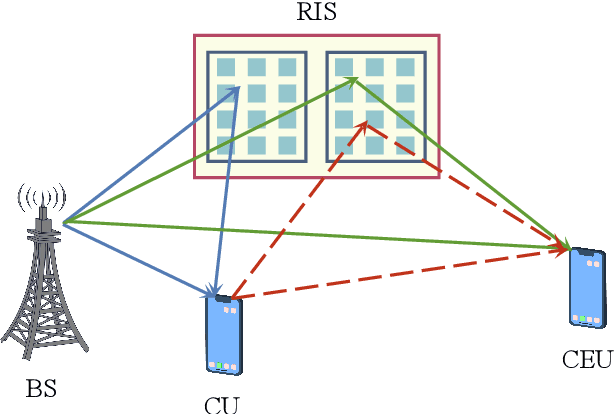
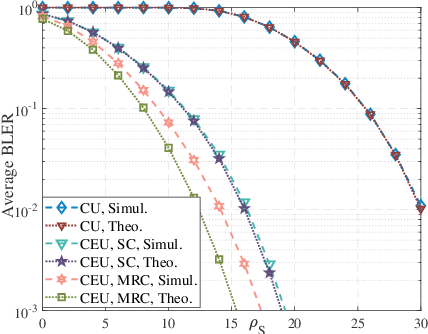
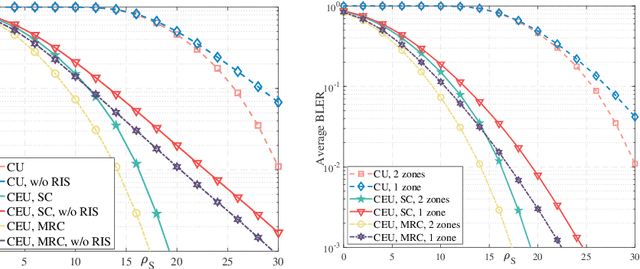
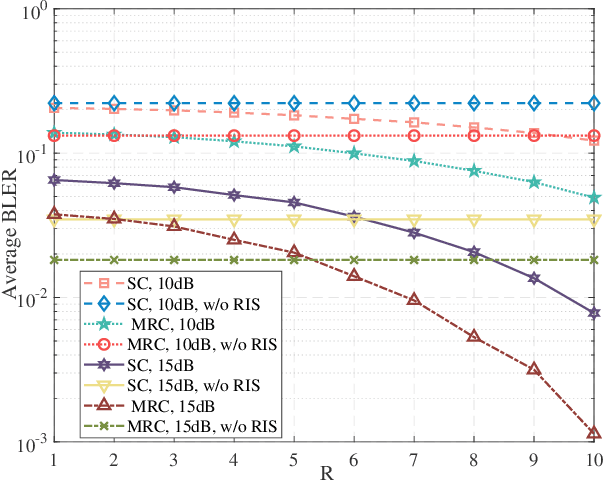
Abstract:In this paper, we conduct a theoretical analysis of how to integrate reconfigurable intelligent surfaces (RIS) with cooperative non-orthogonal multiple access (NOMA), considering URLLC. We consider a downlink two-user cooperative NOMA system employing short-packet communications, where the two users are denoted by the central user (CU) and the cell-edge user (CEU), respectively, and an RIS is deployed to enhance signal quality. Specifically, compared to CEU, CU lies nearer from BS and enjoys the higher channel gains. Closed-form expressions for the CU's average block error rate (BLER) are derived. Furthermore, we evaluate the CEU's BLER performance utilizing selective combining (SC) and derive a tight lower bound under maximum ratio combining (MRC). Simulation results are provided to our analyses and demonstrate that the RIS-assisted system significantly outperforms its counterpart without RIS in terms of BLER. Notably, MRC achieves a squared multiple of the diversity gain of the SC, leading to more reliable performance, especially for the CEU. Furthermore, by dividing the RIS into two zones, each dedicated to a specific user, the average BLER can be further reduced, particularly for the CEU.
FAS-RIS Communication: Model, Analysis, and Optimization
Aug 24, 2024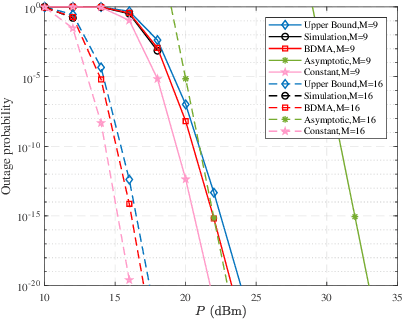
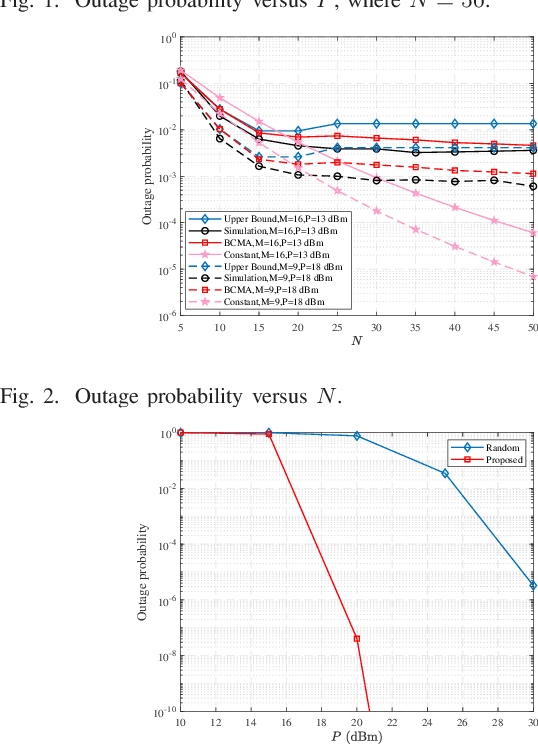
Abstract:This correspondence investigates the novel fluid antenna system (FAS) technology, combining with reconfigurable intelligent surface (RIS) for wireless communications, where a base station (BS) communicates with a FAS-enabled user with the assistance of a RIS. To analyze this technology, we derive the outage probability based on the block-diagonal matrix approximation (BDMA) model. With this, we obtain the upper bound, lower bound, and asymptotic approximation of the outage probability to gain more insights. Moreover, we design the phase shift matrix of the RIS in order to minimize the system outage probability. Simulation results confirm the accuracy of our approximations and that the proposed schemes outperform benchmarks significantly.
Fluid Antenna-Assisted Simultaneous Wireless Information and Power Transfer Systems
Jul 16, 2024



Abstract:This paper examines a fluid antenna (FA)-assisted simultaneous wireless information and power transfer (SWIPT) system. Unlike traditional SWIPT systems with fixed-position antennas (FPAs), our FA-assisted system enables dynamic reconfiguration of the radio propagation environment by adjusting the positions of FAs. This capability enhances both energy harvesting and communication performance. The system comprises a base station (BS) equipped with multiple FAs that transmit signals to an energy receiver (ER) and an information receiver (IR), both equipped with a single FA. Our objective is to maximize the communication rate between the BS and the IR while satisfying the harvested power requirement of the ER. This involves jointly optimizing the BS's transmit beamforming and the positions of all FAs. To address this complex convex optimization problem, we employ an alternating optimization (AO) approach, decomposing it into three sub-problems and solving them iteratively using first and second-order Taylor expansions. Simulation results validate the effectiveness of our proposed FA-assisted SWIPT system, demonstrating significant performance improvements over traditional FPA-based systems.
Rogue Emitter Detection Using Hybrid Network of Denoising Autoencoder and Deep Metric Learning
Dec 01, 2022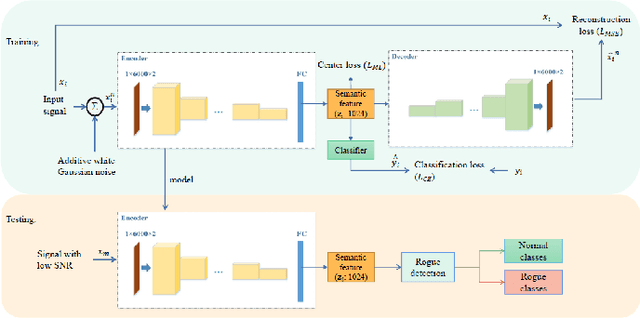
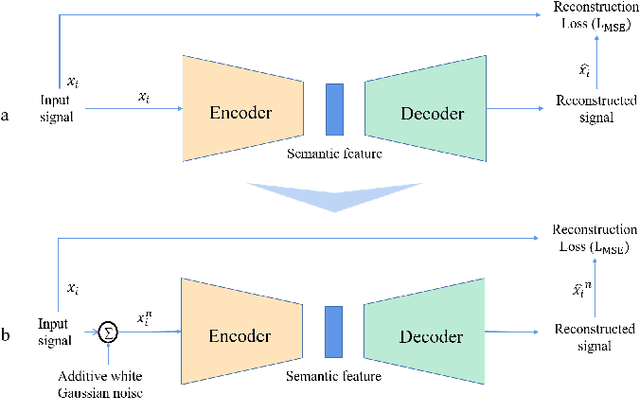
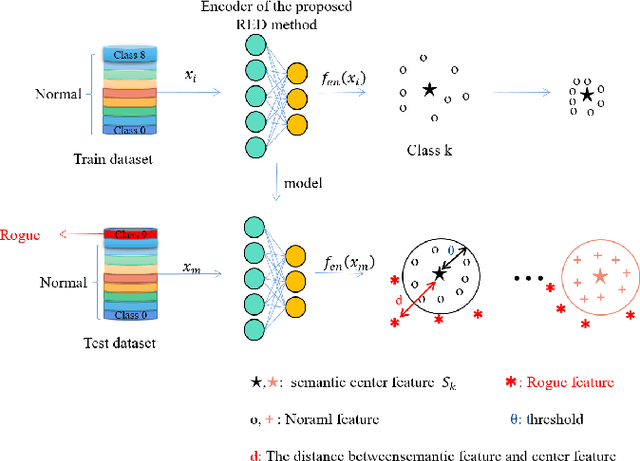
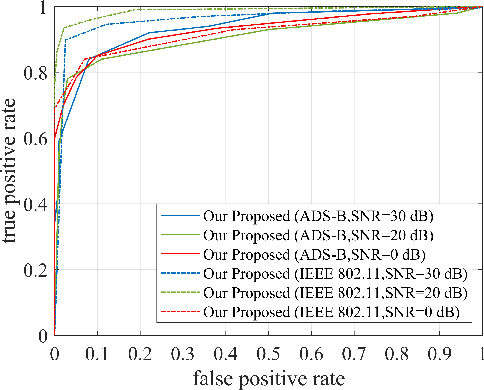
Abstract:Rogue emitter detection (RED) is a crucial technique to maintain secure internet of things applications. Existing deep learning-based RED methods have been proposed under the friendly environments. However, these methods perform unstable under low signal-to-noise ratio (SNR) scenarios. To address this problem, we propose a robust RED method, which is a hybrid network of denoising autoencoder and deep metric learning (DML). Specifically, denoising autoencoder is adopted to mitigate noise interference and then improve its robustness under low SNR while DML plays an important role to improve the feature discrimination. Several typical experiments are conducted to evaluate the proposed RED method on an automatic dependent surveillance-Broadcast dataset and an IEEE 802.11 dataset and also to compare it with existing RED methods. Simulation results show that the proposed method achieves better RED performance and higher noise robustness with more discriminative semantic vectors than existing methods.
Few-Shot Specific Emitter Identification via Hybrid Data Augmentation and Deep Metric Learning
Dec 01, 2022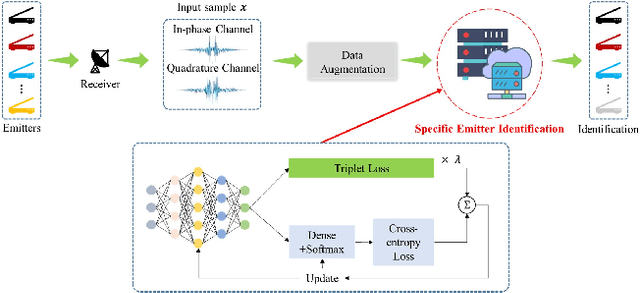
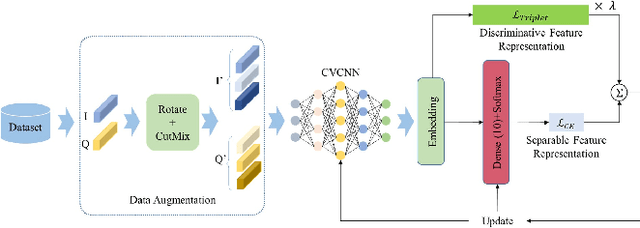
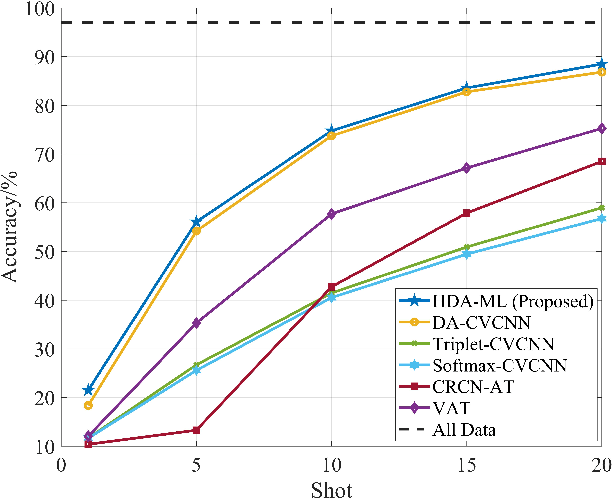
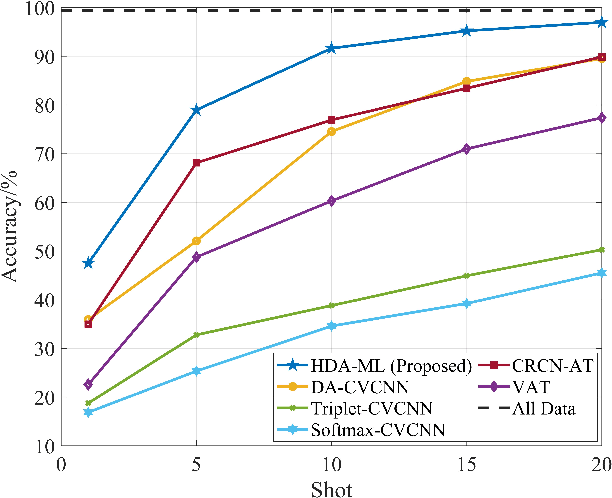
Abstract:Specific emitter identification (SEI) is a potential physical layer authentication technology, which is one of the most critical complements of upper layer authentication. Radio frequency fingerprint (RFF)-based SEI is to distinguish one emitter from each other by immutable RF characteristics from electronic components. Due to the powerful ability of deep learning (DL) to extract hidden features and perform classification, it can extract highly separative features from massive signal samples, thus enabling SEI. Considering the condition of limited training samples, we propose a novel few-shot SEI (FS-SEI) method based on hybrid data augmentation and deep metric learning (HDA-DML) which gets rid of the dependence on auxiliary datasets. Specifically, HDA consisting rotation and CutMix is designed to increase data diversity, and DML is used to extract high discriminative semantic features. The proposed HDA-DML-based FS-SEI method is evaluated on an open source large-scale real-world automatic-dependent surveillance-broadcast (ADS-B) dataset and a real-world WiFi dataset. The simulation results of two datasets show that the proposed method achieves better identification performance and higher feature discriminability than five latest FS-SEI methods.
Semi-Supervised Specific Emitter Identification Method Using Metric-Adversarial Training
Nov 28, 2022



Abstract:Specific emitter identification (SEI) plays an increasingly crucial and potential role in both military and civilian scenarios. It refers to a process to discriminate individual emitters from each other by analyzing extracted characteristics from given radio signals. Deep learning (DL) and deep neural networks (DNNs) can learn the hidden features of data and build the classifier automatically for decision making, which have been widely used in the SEI research. Considering the insufficiently labeled training samples and large unlabeled training samples, semi-supervised learning-based SEI (SS-SEI) methods have been proposed. However, there are few SS-SEI methods focusing on extracting the discriminative and generalized semantic features of radio signals. In this paper, we propose an SS-SEI method using metric-adversarial training (MAT). Specifically, pseudo labels are innovatively introduced into metric learning to enable semi-supervised metric learning (SSML), and an objective function alternatively regularized by SSML and virtual adversarial training (VAT) is designed to extract discriminative and generalized semantic features of radio signals. The proposed MAT-based SS-SEI method is evaluated on an open-source large-scale real-world automatic-dependent surveillance-broadcast (ADS-B) dataset and WiFi dataset and is compared with state-of-the-art methods. The simulation results show that the proposed method achieves better identification performance than existing state-of-the-art methods. Specifically, when the ratio of the number of labeled training samples to the number of all training samples is 10\%, the identification accuracy is 84.80\% under the ADS-B dataset and 80.70\% under the WiFi dataset. Our code can be downloaded from https://github.com/lovelymimola/MAT-based-SS-SEI.
Attention Mechanism Based Intelligent Channel Feedback for mmWave Massive MIMO Systems
Aug 13, 2022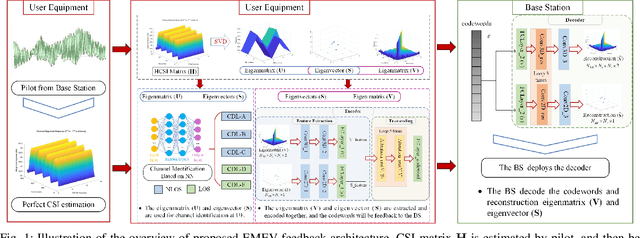
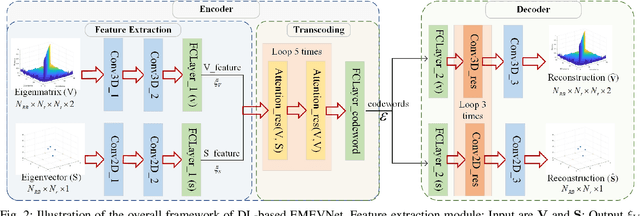
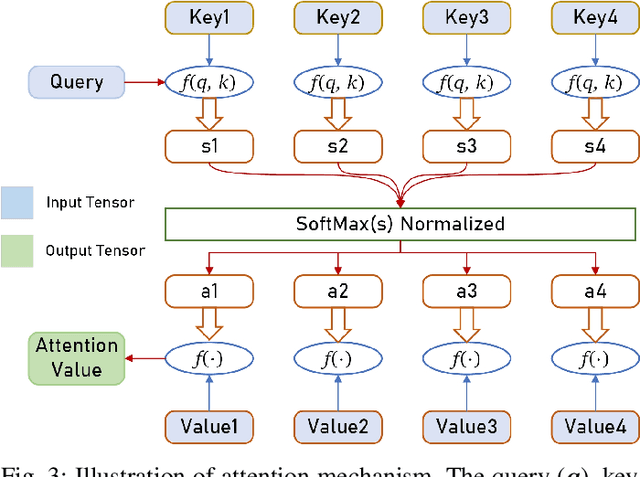
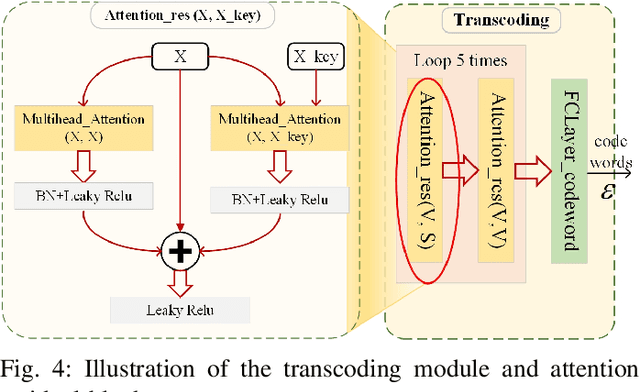
Abstract:The potential advantages of intelligent wireless communications with millimeter wave (mmWave) and massive multiple-input multiple-output (MIMO) are all based on the availability of instantaneous channel state information (CSI) at the base station (BS). However, in frequency division duplex (FDD) systems, no existence of channel reciprocity leads to the difficult acquisition of accurate CSI at the BS. In recent years, many researchers explored effective architectures based on deep learning (DL) to solve this problem and proved the success of DL-based solutions. However, existing schemes focused on the acquisition of complete CSI while ignoring the beamforming and precoding operations. In this paper, we propose an intelligent channel feedback architecture designed for beamforming based on attention mechanism and eigen features. That is, we design an eigenmatrix and eigenvector feedback neural network, called EMEVNet. The key idea of EMEVNet is to extract and feedback effective information meeting the requirements of beamforming and precoding operations at the BS. With the help of the attention mechanism, the proposed EMEVNet can be considered as a dual channel auto-encoder, which is able to jointly encode the eigenmatrix and eigenvector into codewords. Hence, the EMEVNet consists of an encoder deployed at the user and the decoder at the BS. Each user first utilizes singular value decomposition (SVD) transformation to extract the eigen features from CSI, and then selects an appropriate encoder for a specific channel to generate feedback codewords.
 Add to Chrome
Add to Chrome Add to Firefox
Add to Firefox Add to Edge
Add to Edge